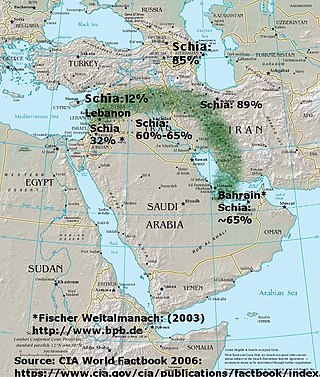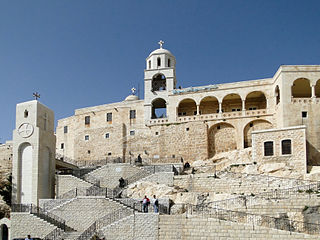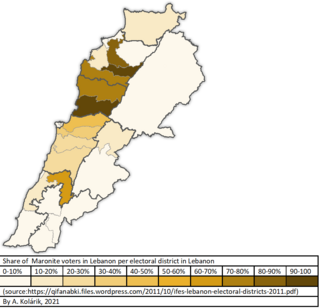
Mount Lebanon is a mountain range in Lebanon. It averages above 2,500 m (8,200 ft) in elevation, with its peak at 3,088 m (10,131 ft). The range provides a typical alpine climate year-round.

The Alawites, also known as Nusayrites, are an Arab ethnoreligious group that live primarily in the Levant and follow Alawism, a religious sect that splintered from early Shi'ism as a ghulat branch during the ninth century. Alawites venerate Ali ibn Abi Talib, revered as the first Imam in the Twelver school, as the physical manifestation of God. The group was founded by Ibn Nusayr during the 9th century. Ibn Nusayr was a disciple of the tenth Twelver Imam, Ali al-Hadi and of the eleventh Twelver Imam, Hasan al-Askari. For this reason, Alawites are also called Nusayris.

Jabal Amil, also spelled Jabal Amel and historically known as Jabal Amila, is a cultural and geographic region in Southern Lebanon largely associated with its long-established, predominantly Twelver Shia Muslim inhabitants. Its precise boundaries vary, but it is generally defined as the mostly highland region on either side of the Litani River, between the Mediterranean Sea in the west and the Wadi al-Taym, Beqaa and Hula valleys in the east.

Christianity in Lebanon has a long and continuous history. Biblical Scriptures show that Peter and Paul evangelized the Phoenicians, whom they affiliated to the ancient Patriarchate of Antioch. Christianity spread slowly in Lebanon due to pagans who resisted conversion, but it ultimately spread throughout the country. Even after centuries of Muslim rule, it remains the dominant faith of the Mount Lebanon region and has substantial communities elsewhere.

Several different denominations and sects of Islam are practised within Syria, whom collectively, constitute approximately 87% of the population and form a majority in most of the districts of the country.

The Shia Crescent is the notionally crescent-shaped region of the Middle East where the majority population is Shia or where there is a strong Shia minority in the population.

Christians in Syria made up about 10% of the pre-war Syrian population. The country's largest Christian denomination is the Greek Orthodox Church of Antioch, closely followed by the Maronite Church and the Assyrian Church of the East; the cities of Damascus and Aleppo are believed to have the largest number of Christians in Syria. There is a small minority of Protestants in the country.
Islam is historically divided into two major sects, Sunni and Shia Islam, each with its own sub-sects. Large numbers of Shia Arab Muslims live in some Arab countries including Lebanon, Yemen, Bahrain, Iraq, Saudi Arabia, Kuwait, Oman, the UAE, and Qatar.
Religion in Syria refers to the range of religions practiced by the citizens of Syria. Historically, the region has been a mosaic of diverse faiths with a range of different sects within each of these religious communities.

Lebanese nationalism is a nationalist ideology which considers the Lebanese people as a separate nation independent from the Arab world and strives to maintain Lebanon as an independent nation-state. The ideology may consider the Lebanese people to be direct descendants of the Phoenicians, a concept associated with Phoenicianism.

Sayyidah Zaynab Mosque is a mosque located in the city of Sayyidah Zaynab, in the southern suburbs of Damascus, Syria. According to Twelver Shi'ite tradition, the mosque contains the grave of Zaynab, the daughter of Ali and Fatimah, and granddaughter of the Islamic prophet Muhammad. Ismaili Shia tradition place Zaynab's tomb in the mosque of the same name in Cairo, Egypt. The tomb became a centre of Twelver religious studies in Syria and a destination of mass pilgrimage by Twelver Shia Muslims from across the Muslim world, beginning in the 1980s. The zenith of visitation normally occurs in the summer. The present-day mosque that hosts the tomb was built in 1990.

Nabi Habeel Mosque, or "Mosque of the Prophet Abel", is a shrine dedicated to Habeel, located on the west mountains of Damascus, near the Zabadani Valley, overlooking the villages of the Barada river, in Syria, the Levant.

Lebanese Shia Muslims, communally and historically known as matāwila, are Lebanese people who are adherents of Shia Islam in Lebanon, which plays a major role alongside Lebanon's main Sunni, Maronite and Druze sects. The vast majority of Shia Muslims in Lebanon adhere to Twelver Shi'ism, making them the only major Twelver Shia community extant in the Levant.

Sayyidah Zaynab, commonly known as Sitt Zaynab, is a town in the Rif Dimashq Governorate of Syria, 10 km (6 mi) south of Damascus, the national capital. With a population of 136,427, it is the 10th most populous city in Syria and the most populous satellite city of Damascus. Administratively, the town is located in Markaz Rif Dimashq district and belongs to the nahiyah ("subdistrict") of Babbila. The municipality of Sayyidah Zaynab is still considered as a rural community by the governorate of Rif Dimashq. The city contains the Qabr Essit Palestinian refugee camp.

Lebanese Maronite Christians refers to Lebanese people who are members of the Maronite Church in Lebanon, the largest Christian denomination in the country. The Lebanese Maronite population is concentrated mainly in Mount Lebanon and East Beirut. They are believed to constitute about 30% of the total population of Lebanon.

The Harfush dynasty was a dynasty that descended from the Khuza'a tribe, which helped, during the reign of Muhammad, in the conquest of Syria. The Harfush dynasty controlled the Baalbek District and several parts of the Bekaa Valley. Their being Shiaa was a major factor in the rivalry between the Harfushes and the Lebanese Druze Maan family.

In early 2016 there was a series of bombings in the mainly Shi'ite town of Sayyidah Zaynab and attributed to Islamic State of Iraq and the Levant.
The Kisrawan campaigns were a series of Mamluk military expeditions against the mountaineers of the Kisrawan, as well as the neighboring areas of Byblos and the Jurd, in Mount Lebanon. The offensives were launched in 1292, 1300 and 1305. The mountaineers were Shia Muslim, Alawite, Maronite and Druze tribesmen who historically acted autonomously of any central authority. The Maronites in particular had maintained close cooperation with the last Crusader state, the County of Tripoli. After the fall of Tripoli to the Mamluks in 1289, the mountaineers would often block the coastal road between Tripoli and Beirut, prompting the first Mamluk expedition in 1292 under the viceroy of Egypt, Baydara. During that campaign, the Mamluks, spread along the coastal road and cut off from each other at various points, were constantly harried by the mountaineers, who confiscated their weapons, horses and money. Baydara withdrew his men only after paying off the mountain chiefs.
The Kisrawan or Keserwan is a region between Mount Lebanon and the Mediterranean coast, north of the Lebanese capital Beirut and south of the Ibrahim River. It is administered by the eponymous Keserwan District, part of the Keserwan-Jbeil Governorate.

This article lists historical events that occurred between 801–900 in modern-day Lebanon or regarding its people.
















